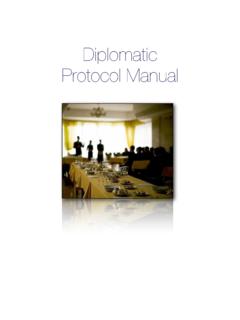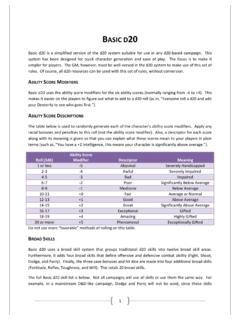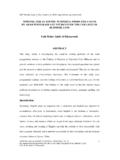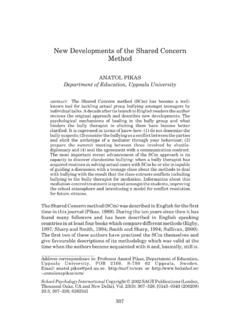Transcription of Thailand: Cultural Background for ESL/EFL Teachers
1 thailand : Cultural Background for ESL/EFL Teachers By Tuong Hung Nguyen, Cuyahoga Community College Do good, receive good; do evil, receive evil Thai Saying Overview The Kingdom of thailand is situated in the center of Southeast Asia, bordering Burma, Laos, Cambodia and Malaysia. The country is shaped like the head of an elephant with the trunk pointing south. Covering a total area of 514,000 sq km (198,445 sq mi), thailand is rich in agricultural and mineral resources, making it more prosperous than many other nations in the Far East. thailand has a population of 64 million (2003), of which 75 percent are Thai a Mongoloid subgroup with a light complexion. The largest minority is the Chinese (14%) and other minority groups include Malay, Khmer and Vietnamese inhabitants.
2 The official national language , spoken by a large majority of the population, is Thai. Lao, Chinese, Malay and Khmer are also spoken in thailand . English, a mandatory subject in secondary schools, is widely used in commerce and government, particularly in Bangkok and other major cities. Although thailand has an ancient civilization, with Bronze Age artifacts from as early as 4000 BC, it did not emerge as a kingdom until the 13th century under the first known King Mengrai. The country engaged in successive wars with Burma and Cambodia, and then was exposed to European powers, resulting in the loss of territory in the east to France (1893) and in the south to Britain (1909). In a bloodless coup d etat in 1932, the absolute monarchy was replaced by a constitutional monarchy with a parliamentarian form of government.
3 During World War II, the country was occupied by the Japanese. Over the next several decades, the political arena was very unstable with violent student demonstrations, rampant coups and intermittent military governments. Consequently, thailand suffered at the hands of all these political upheavals. While the nation s political situation has become more stable toward the end of the 20th century, thailand has begun to face numerous social problems resulting from the rapid economic changes. Thais are very proud of their nation - the only country in Southeast Asia that has never felt the yoke of foreign domination or colonialism throughout its long history. To this effect, Siam (as it was known to the world until 1939) was renamed Prathet Thai or thailand meaning Land of the Free.
4 Briefly, the main elements that have molded thailand s Cultural identity can be stated in the unswerving allegiance to independence, the sagacity of diplomacy, the loyalty to the monarchy, the deep-rooted belief in Buddhism and the love of family. Buddhism, the national religion of thailand , is the professed faith of 95 percent of the population. The rest of the population embraces other religions, such as Islam, Christianity and Hinduism. The basic tenets of Buddhism can be summarized as follows: One should show kindness and tolerance toward others. Everything a person does has an effect; hence, what a person is and what happens to him/her is the result of his/her own actions or karma. Buddhists believe in reincarnation, , a person has other lives before and after this one; the next life one has depends on one s deeds in this life.
5 Life is suffering, which comes from one s craving. Therefore, one should give up ambition or greed and do good deeds to improve one s karma. Thai culture is closely associated with Buddhist teachings. One is expected to do tum bun good deeds or make merit in one way or another. Thais are apt to support charities and social activities. Many Thai men spend several months as monks in their life for this purpose. Thais have been known to be very good-natured and easy-going. When something unfortunate happens, a Thai usually says mai pen rai, a phrase meaning no problem or it doesn t matter. This comes from Buddhist ideals of peace and harmony, of avoiding conflict or displays of emotion. It is true that smiling comes easily to most Thai people.
6 That is why they have nicknamed their country Muang Yim - Land of Smiles. Like most other Asian cultures, Thai values are more or less influenced by Confucianism. They are chiefly: filial piety, respect for age, seniority and hierarchy, face, deference, dignity, honor, true friendship, dislike of pomposity and arrogance, interest in learning, and belief in moderation. Family ties and filial piety play an important role in Thai society. Several generations may live in the same household and take good care of one another. Thais have a very high respect for parents and the elderly. Children are taught from childhood to follow the advice of their elders. They are not taught to talk back or voice contrasting views. Ancestor veneration is a hyphen between the dead and the living and a strong tie between members of the same ancestry.
7 Familial respect and respectability is extended to respect for authority and status in Thai hierarchical society. For example, it would be very offensive to make a joke about the King and Queen or to lick a stamp with the King s picture. These respectful attitudes are evident in linguistic behavior. Thai abounds in kinship terms that can show the right degree of respect, deference and intimacy. Thais highly value friendship and tend to seek friendships of a permanent nature. They distinguish between eating friends who only appear when in good times and friends to death who are always there in good or bad times. Good friends for Thais are reliable and tried-and-true friends. To perpetuate friendship, Thais use kinship terms ( , older brother, younger sister depending on age) to address each other, as if they were blood siblings.
8 Specifically, Thai friends of mine are gracious, sensitive and considerate of others feelings while still respecting each other s privacy. As is true of most Asian cultures, public displays of male-female affection are not common among Thais, although members of the same sex may touch or hold hands with each other. The traditional and most usual form of greeting is the wai - each person puts the palms together, with fingers at the chest, and bows slightly to the other person. The higher the wai and the lower the head, the more respect is shown. The wai can mean not only hello , but also thank you, good-bye or even I m sorry. However, those who come in contact with Western culture have become accustomed to the handshake.
9 Touching someone s head or pointing at something with the feet is a taboo. Beckoning should be done with the palm down while pointing at someone is considered rude. Since education is free and compulsory for all children between the ages of 7 and 15, thailand has a high literacy rate of 94 percent, compared to that of most other countries of Southeast Asia. Children go to either public primary schools or those operated by Buddhist monasteries. Nowadays, many people can afford to study at American high schools, colleges and universities on their own or through teacher and student exchange programs. Thai full names have the same order as Western names: given name + surname, with no middle name. Two typical names, for example, are Malee Amatayakul and Somchai Sookmahk. In addressing, Thai people use the given name or, more politely, a title plus the given name.
10 In this case khun, meaning Mr., Mrs. or Miss, is put before the given name, , Khun Somchai or Khun Malee. A kinship term ( , older brother or uncle) or professional term ( , Dr.) may also be placed before the given name in addressing when the relationship is clear. As a traditional practice, Thai wives take their husbands surnames, as do their children. While Thai people still believe in Buddhist philosophy of life and Confucian values, many of the practices are changing as people are adopting new fashions, customs, and ways of living from the West. However, many Thais do not see this development as a need to change their religious and traditional values. For many Thais, to be westernized is not always complimentary. In the United States, Thais make up a smaller community than those from other Southeast Asian countries.





